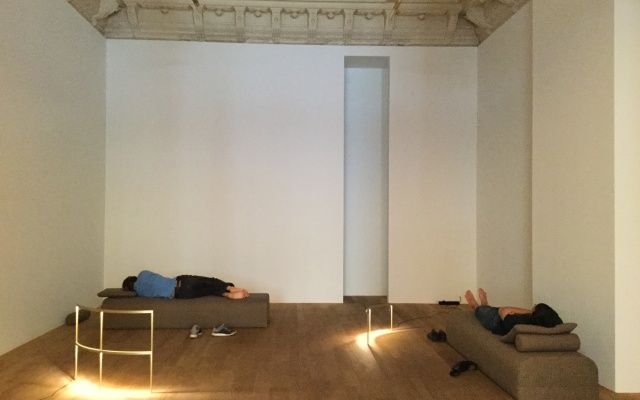Graduating from the logic of mediums; negating the exhibition area as a place centered on the visual perception of artworks despite addressing all the senses; focusing on the function of bodies (the artist’s, the viewer’s); nursing an anthropological obsession that integrates different models of stage design into the field of art (institutional, political, mainstream, non-artistic, non-Western); stepping outside the museum, outside of art and turning to the theatricality of daily life; embracing the logic of the fragment, the manifold, the heterogeneous; displaying emptiness; participating; asserting the place of the subject; these are all notions through which theater, theatricality, and the stage have successfully added a new chapter to the history of modern art until its most recent practices in the last ten years or so.1 To outline these new genealogies, it was necessary to shift and multiply perspectives in order to complexify the reinterpretation of a story based upon other models, which include theater; to generate a renewed speech, at the expense of new articulations that connect art with other practices, also derived from fields long considered parallel (from theater in particular, but also more broadly from the so-called performing arts – dance, poetry, music), all the way up to new forms of history, the history of techniques, sciences and the occult, in order to finally emancipate the making of art history from the ideological norms of self-referential historiography.
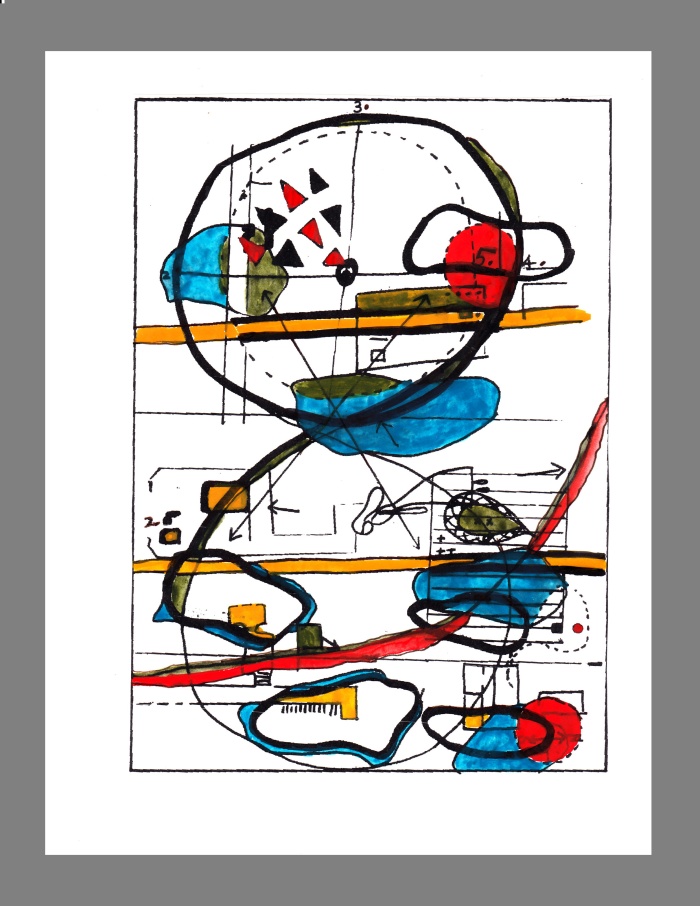
Susan Hiller, Dream mapping, 1973-1974. Grupowa mapa wielokrotnego snu. Dzięki uprzejmości artystki i Lisson Gallery, Londyn
Nevertheless, things have gradually re-established themselves in parallel, becoming fixed and hermetic. Theater – in as much as it carries with it a number of other truisms, from the simultaneous perception of actions, the mobilization of techniques, of movement, voice, text, sound and light, to the perception of space and the relationship between the audience and the stage, in as much as it partly belongs to the history of the “total” artwork, expressing a multi-sensory perception, that of an action that unfolds through time, before the eyes of the audience – has produced (in its own way in the field of art) not only other possibilities for artists, but also other established forms both for them and for art venues, and institutions as it happens. Indeed, most major museums, art venues and even galleries nowadays offer a program of performances, integrating a “performative” dimension into their project, and opting for a “live” strategy to create a “buzz,” even designing parts of their exhibitions as “experiences” or festivals, to the point of turning their exhibitions into temporal objects, thereby bringing together art, the stage and the performance. Time has come to re-open interpretation, to use new criteria, to find different historical and conceptual reference points in order to once again address the issue of theater in a vibrant manner.
Today, a darker side of theatricality exists as a model that is untouched by the history of art, maybe due to its relative invisibility or at least to its particular “visuality.” In contrast to a fantasized “opening” of the work, a desire for immersion historically related to a somewhat utopic “total” perception, which rallies artists around a powerful form of expression, immersing viewers in an overwhelming environment, artistic proposals that follow a discrete dynamic make up a historical chain whose story remains to be written. In contrast to the centripetal movement that drove projects associated with “extended” art forms in the late 1950s featuring collective actions, multiple projections, explosions of light, colors and sounds during concerts as well as psychedelic light shows in the mid-1960s, and an introspective centrifugal form that was not only geared towards the demonstration and staging of external stimuli but towards a theater located inside the viewer’s body, unfolding directly on the “other stage” (the stage of the subjects’ actual physiologies, their mind, their subconscious, to use a psychoanalytic term), a series of artistic proposals make up a historical chain that suggests a different way of telling the story that has unfolded in the last 50 years.
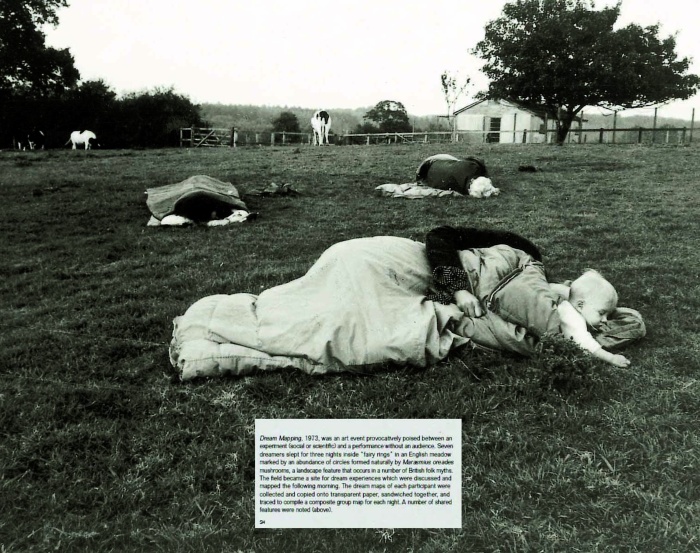
Susan Hiller, Dream mapping, 1973-1974. Pole snu. Dzięki uprzejmości artystki i Lisson Gallery, Londyn
Our story might begin one day, or rather one night in 1973 in the English countryside, when Susan Hiller set up a Dream Mapping session with no audience other than the participants. The artist’s objective was to enable attendees to share a period of collective dreaming in a specific place, a meadow marked with “fairy rings” (naturally occurring rings of mushrooms which form in green areas according to a well-known phenomenon, and result in rings that can grow up to several hundred yards in diameter). The experience was carried out with the aim of mapping out the places visited and outlining the constellation of images that the participants experienced during their oneiric journey. The literature does not specify if the session was restricted to women, but some images feature participants dreaming with their underage children snuggling up against them. At the end of the experiment the dreams were discussed, described, and written down on transparent sheets of paper before finally being superimposed in order to create a “collective image.” An important distinction must be made with experiments carried out in the same period by artists such as Larry Miller and Matt Mullican, who used hypnosis on themselves during performances to explore their inner selves and to bring back new forms2 from this foray into the unknown. What Susan Hiller offers is really the opposite: To the observation of the artist staging his own possession, which certainly fits in with a history of imagination that dates back to Romanticism, Hiller replies with an experiment geared towards the participants. They will be the ones to experience what is unfolding in their imagination, tending towards the age-old fantasy of connected dreaming. Nurtured with forms rooted in British folklore, while referring to the use of mycology in the clandestine practice of witchcraft by women, the artist forms a network, a machine for imagination with her Dream Mapping.
In April 2008, Lithuanian-born curator Raimundas Malasauskas inaugurated a series of exhibits entitled Hypnotic Show in San Francisco. In the form of meetings organized in association with Marcos Lutyens, a British hypnotist based in Los Angeles, the project offered participants the ability to experience works actually unfolding in the minds of the viewers. For this purpose, the curator invited a series of artists to devise scripts, scenarios and concepts that Lutyens could interpret and use as raw material for his sessions. Like a traditional hypnosis session, the audience, sitting in a half-circle around the hypnotist in the empty exhibition area, was gradually brought to a state of trance. Each session was an opportunity for Malasauskas to draw from the range of ideas provided by the artists and to outline a different route for the audience, who experienced the successive works with their eyes closed. In a tradition that could be traced back to Fluxus3, Hypnotic Show echoes – albeit with a touch of humor – stage hypnosis, a symbol of highly codified mainstream theater featuring a sort of fascination for mind control. Nevertheless, Malasauskas’ project evades the simple formal misappropriation of its model by infusing it with content (the artists’ works or scripts) which itself plays upon the possibilities of hypnosis and the limits of imagination, to offer a unique form of aesthetic experience, the experience of an exhibition seen not through, but behind the eyes, i.e. in the mind’s eye.
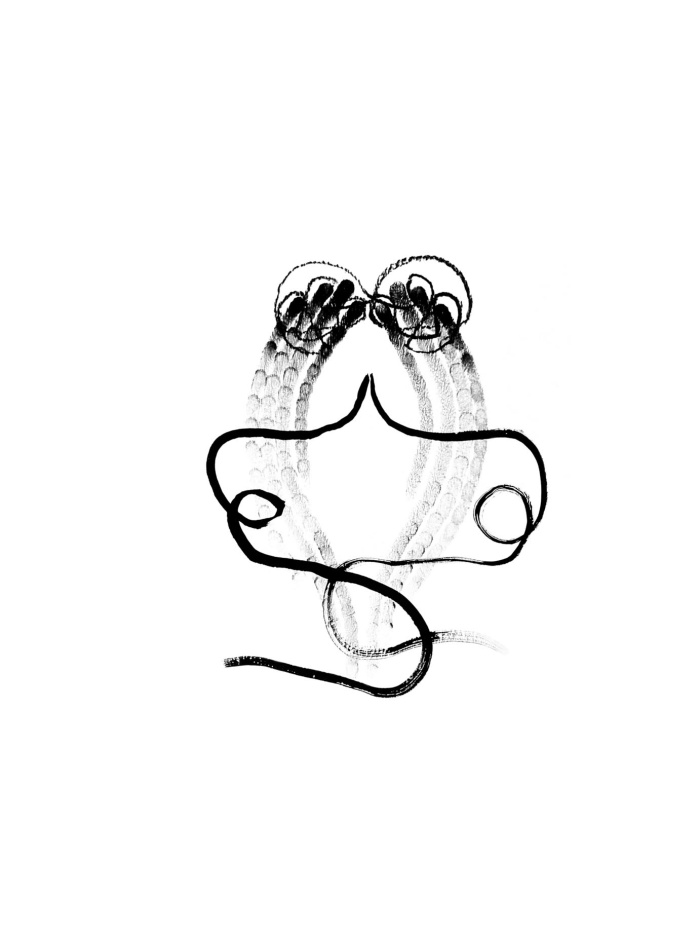
Insygnia teraźniejszości, wykonane przez Judith Braun, Audrey Cottin i Marianę Castillo Deball. W ramach: The hyponotic show, kuratorowanego przez Raimundasa Malasauskasa, Jessica Silverman Gallery, San Francisco, 2008
A recent series of works by Joachim Koester, initiated in 2015, takes the form of a soundtrack that the audience is invited to experience, lying down, away from any visual stimulus in order to immerse themselves in the aural story that the artist offers. The first, Department of Abandoned Futures, had initially been written for Malasauskas’ Hypnotic Show. Koester, in association with artist Stefan A. Pedersen, used it as the first stage in this series of meditative works, each with a plot based on a visit to a particular place, guided by the hypnotic voice of a narrator. The second presented Passaic, a “city forgotten by time” as artist Robert Smithson described it in a text from 1967 (Drifting through Passaic, 2016). The third was dedicated to Marcel Broodthaers’ imaginary museum as a possible point of origin for a form of institutional critique (Museum of Modern Art, Department of Eagles: Patterns, Shimmers, Scenes, 2016). Following on from the investigations specific to Koester’s work since the end of the 1990s, whose method, comparable to that of “ghost hunters,” consists of roaming places haunted by experiments that have remained in the shadows of history, and to identify traces of the passage of obscure figures in modernity, this series proposes the eyes-closed exploration of loaded places. Koester’s work proposes a dreamlike journey, set to Pedersen’s mesmerizing layers of sound. The text invites the audience to gradually descend into a deep, unfathomable space, echoing one’s immersion into history and the audiences’ inner selves. Then movement begins, accompanying the participant into the semi-conscious parts of their minds, in search of images characteristic of hypnagogic hallucinations that form in the brain between sleep and waking, on the edge of consciousness. If the form of Koester and Pedersen’s project is undoubtedly rooted in the psychoacoustic experimentations characteristic of New Age4 auto-suggestion sound productions, the type of “pre-image” they form in the minds of the audience relates as much to the way writer Henri Michaux used to conduct his self-observation sessions under the influence of various substances (hashish, mescaline, alcohol), “circulating in his body” and attempting to grasp the “visual images” provided by self-induced intoxication.
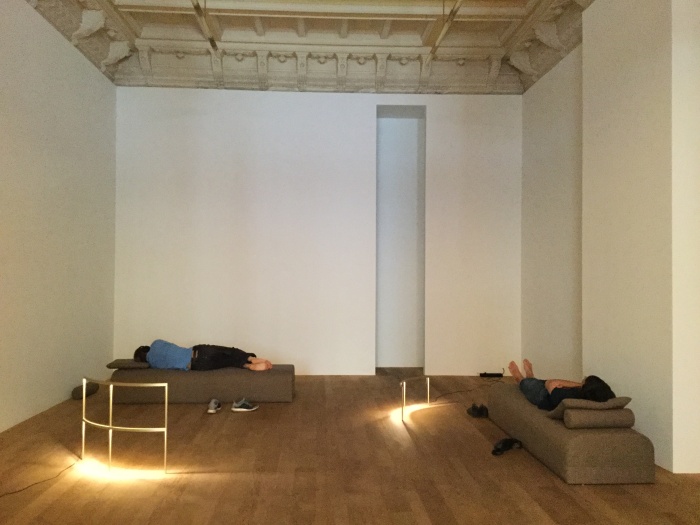
Joachim Koester i Stefan A. Pedersen, Muzeum sztuki współczesnej. Departament orłów. Instalacja dźwiękowa. Gallery Jan Mot, 2016. Dzięki uprzejmości artysty
“It may be that cinema, in general, is hypnotic in nature,” writes Jean-François Chevrier in a recent book about “artistic hallucination.”5 According to the art historian, a scene such as the anesthesia at the dentist’s in Erich von Stroheim’s Greed (1924) – whose position is strangely reminiscent of a hypnotized subject, or of the viewers in Koester’s work – is similar to a metaphor, an image within the image, a mirror scene that reflects the very position of the viewer in the cinema, in whom the projection system, the editing and silent staging of the bodies puts in a state of trance. Further on, Chevrier makes the assumption that the invention of close-ups relates to the same idea, visually substantiating the way in which cinematic effect mimics an immersion into the mind of a character (the actor), and therefore the subject, echoing back to the minds of the viewers themselves who, sitting in their “operation” seat, lose track of time and, in short, leave their body. At the limits of what can be perceived visually, Malasauskas and Koester’s experiments intensify, stage, push to another level the logic of the cinematic close-up by allowing the projector to enter directly into the participants’ consciousness. Nevertheless, contrary to what might first spring to mind, it is possible that these works, much like Hiller’s collective experience, entail something very different from a form of possession. Indeed, the relative passivity of the subject, the distortion of his attention, the inner drifting that his projects enable, result not so much in a form of mind control, as would suggest the use of hypnosis, dream experiences and hallucination, but rather a latent area between the work and the viewer, a floating, uncontrolled perception; a way of opening consciousness through a game between the transmitter and the receiver onto the “plenitude of imagination.”
Giorgio Agamben recalls the way in which the status of imagination changed at some point in history. According to the philosopher, in antiquity, imagination, which is now banned from the field of thought due to its alleged unreality, was, on the contrary, for ancient peoples, the “ideal medium” for all forms of knowledge – imagination being the only tool to establish a link between the perceptible and the intelligible world.6 Agamben recalls that in the ancient world, dreams had a privileged relationship with a certain idea of truth: Here, he alludes to oneiromancy as well as to medical practices that were used when patients dozed (e.g. incubation). Finally, he quotes a study by anthropologist and psychoanalyst Georges Devereux who claimed that for the Mohave, “powers were acquired in dreams,” or even better: “If knowledge was acquired while awake, it would remain ineffective as long as it had not actually been dreamt.”7 Agamben goes on: According to him, since the birth of modern science and Descartes’ theories, the imagination, as an act of mediation between thought and experience, between mind and body, has been gradually banished. Nowadays, “it is its combinatorial and hallucinatory nature, once marginalized, that has taken center stage.”8 From the perspective of such a genealogy, Hiller’s works, Malasauskas’ project and Koester’s work are clearly rooted in a history of imagination that perpetuates that other tradition.
Theoretician Jean Starobinski identifies traces of this parallel filiation in the 16th century,9 originating in heretic Italian philosopher Giordano Bruno’s cosmic theories of imagination and the image as “first body of thought,” echoed by Swiss physician Paracelsus, who considered imagination as “an inner sun acting on its own realm,”10 and in another way in Franz-Anton Messmer’s research into imaginary fluids and animal magnetism in the late 18th century, which would lead to the actual invention of hypnosis. A trace can be found again a little later in modernity in the debate between distracted perception-adept André Breton and fierce opponent of hypnosis Sigmund Freud, as well as in the historical coincidences that connect the history of sciences, of surrealism and of art in the early 1970s which brought together, on an imaginary stage, experimental mental therapies, New Age technological mysticism and Miller’s, Mullican’s, and Hiller’s works. At the other end of the story, it is precisely in this paradoxical articulation between mind control and emancipation, between imagination and truth, between immersion and what Michel Foucault called, in The Use of Pleasure, a “withdrawal from oneself,” that Malasauskas and Koester’s proposals form a project, which should indeed be described as an attempt to place the issue of experience at the heart of this specific, subconscious area, or different consciousness – that of a singular dramaturgy, on this inner, secret and invisible stage.
Yann Chateigné Tytelman
Translated from the French by AJS Craker
BIO
Yann Chateigné Tytelman is a curator, art historian, and writer based in Geneva. He is the dean of visual arts at the Geneva School of Art and Design. He has been a contributor to Artforum, Frieze, Kaleidoscope, Mousse, Spike and several catalogs and collective publications. Recent projects include Lepidoptera Lodge as part of Joachim Koester’s In the Face of Overwhelming Forces, Camden Arts Center, London (2017), Immersion, LiveInYourHead, Geneva (2017), and 1977, L’Onde, Vélizy, France (2017).
Cover image: Joachim Koester and Stefan A. Pedersen Museum of Modern Art, Department of Eagles. Sound installation. Gallery Jan Mot, 2016. Courtesy of the artist
1 Among noteworthy exhibitions that focused on the issue of theatre at the end of the past decade, let us mention, in a non-exhaustive manner: La Monnaie Vivante / The Living Currency, curated by Pierre Bal-Blanc, various venues, various versions (2006 – 2010), The World as A Stage, curated by Jessica Morgan and Catherine Wood, Tate Modern, October 2007 – January 2008, and Accecare l’Ascolto / Blinding the Ears, curated by Andrea Bellini, Turin, various venues, in the context of Artissima, November 2009. Although it is customary not to name oneself, I find it difficult not to mention A Theatre Without Theatre, which I set up with Bernard Blistène and Pedro G. Romero, Macba, Barcelona, May – September 2007, Museu Berardo, Lisbon, November 2007 – February 2008.
2 In 1973, Fluxus associate Larry Miller carried out Mom-Me, a genealogical exploration under the influence of hypnosis. That same year, Matt Mullican’s works produced under hypnosis, show the artist acting under the influence of a subconscious process, becoming someone else, a different character. In a recent essay, Pascal Rousseau recalls the significance of the parallel diffusion, in the US, of Milton Hyland Erickson’s theories. Erickson reintroduced within new forms of experimental psychotherapy the practice of hypnosis, which had gradually been banished since Sigmund Freud’s abhorrence of it. Jack Haley’s The Uncommon Therapy, which offers a popularized account of it, was published in that same year (1973).
3 Fluxus artists have been more interested in telepathy than hypnosis, as exemplified by Robert Filliou’s Telepathic Music series, to mention one of its more famous proponents. However, another genealogy that remains to be drawn might connect the history of Conceptual Art with the one of Inception: Why not consider a work by Lawrence Weiner, Robert Barry or Ian Wilson as an idea that would, in a comparable way, take form in the mind of the viewer? The Hypnotic Show, finally, radicalizes this mental process while revealing these new interconnections in art history between “Event” and “Concept”, through the concept of what one might call “Imagination”.
4 We are made to think of the Valley of the Sun tapes by Californian New Age hypnotherapist Dick Sutphen who, since the early 1970s, commercialized, by mail order, a series of “mental programming” sound productions to meet various physiological situations, existential concerns and spiritual aspirations, and to research by philanthropist and sound engineer Robert Monroe who, in the same years, developed a technology called “hemi-sync” (Hemispheric Synchronisation) enabling access through listening, according to the institute he established in Virginia in 1974, to altered states of consciousness and thereby authorizing a transformation of the daily, and inner life of its users.
5 See Jean-François Chevrier, L’hallucination artistique; de William Blake à Sigmar Polke, Paris, L’Arachnéen, 2012.
6 Giorgio Agamben, Enfance et histoire. Destruction de l’expérience et origine de l’histoire, Paris, Payot & Rivages, 1978 – 1989, p. 46.
7 Ibid, p. 46.
8 Ibid, p. 46.
9 See Jean Starobinski, La Relation critique, chapter “L’empire de l’imaginaire. Jalons pour une histoire de l’imagination,” Paris, Gallimard, coll. “Le chemin,” 1970, p. 185.
10 Walter Pagel, Paracelsus, Basel, 1958, p. 121-125, quoted by Jean Starobinski, Ibid, p. 186.



